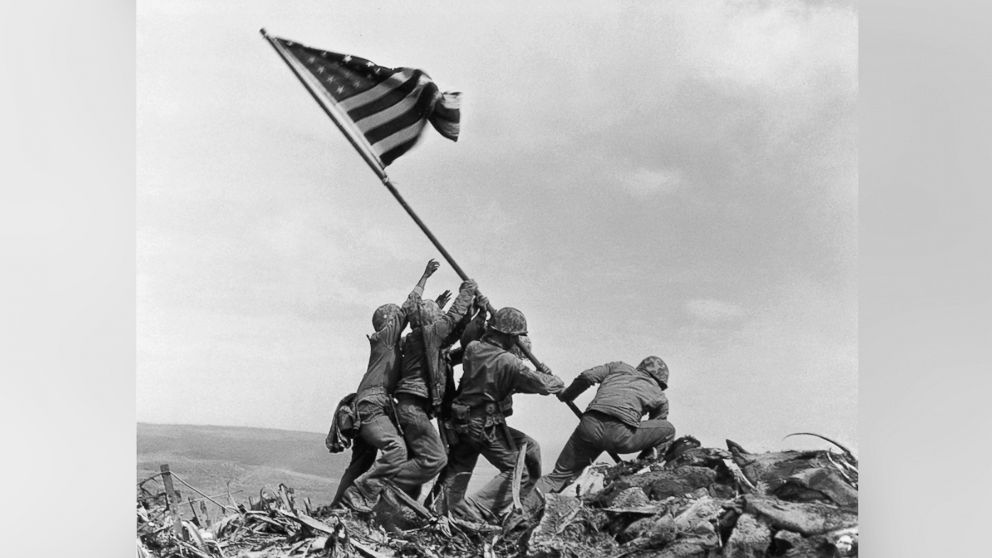Marines Acknowledge Man in Iconic 1945 Iwo Jima Photo Was Misidentified
Evidence gathered by amateur historians had prompted a review.

— -- The Marine Corps has determined that a Marine in the iconic World War II photo of the flag raising on Iwo Jima's Mount Suribachi was misidentified.
A review prompted by evidence gathered by two amateur historians determined that Pfc. Harold Schulz, who died in 1995, was actually the individual previously believed to be Navy Pharmacist's Mate 2nd Class John Bradley, whose story was told in the bestselling book "Flags of Our Fathers.”
The Marines have concluded that Bradley was involved in the first flag raising on Mount Suribachi, but the famous photo taken by Associated Press photographer Joseph Rosenthal captured the second flag raising of a larger U.S. flag on the mountain during the battle for the strategic island where 6,500 U.S. service members died.
Several months ago, Marine Commandant General Robert Neller formed a review panel "to consider all available images, film, statements and previous investigations."
The panel was headed by retired Marine Gen. Jan Huly and was made up of both active and retired Marines and two military historians.
Neller ordered the review after researchers working with a Smithsonian Channel documentary on the flag raising had asked the Marine Corps to consider their theory that one of the Marine flag raisers had been misidentified shortly after the photo became popular. The image captured in the photo has since become synonymous with the Marine Corps and is portrayed in the U.S. Marine Corps Memorial in Arlington, Virginia, that overlooks Washington, D.C.
The work of amateur historians Eric Krelle of Omaha, Nebraska, and Stephen Foley, of Wexford, Ireland, was profiled in 2014 by the Omaha World-Herald. Their analysis of photos taken on Mount Suribachi the day of the flag raisings suggested that the man identified as Bradley was actually Schultz.
The panel began reviewing available materials in early April and recently presented their findings and recommendations to Neller.
The Marine statement said Neller and the review panel came to the same conclusion "that one of the six men in the Rosenthal photograph was misidentified."
"The Marine Corps now believes Navy Pharmacist's Mate 2nd Class John Bradley was not in the Rosenthal image, but was involved in the initial flag raising hours before the famous photo was taken," the statement said. "Based upon the evidence reviewed, another Marine, Private First Class Harold Schultz, from Detroit, Mich. was the sixth man caught in the frame of what is considered the most famous war photograph.
Neller said, "Our history is important to us, and we have a responsibility to ensure it's right.”
"Although the Rosenthal image is iconic and significant, to Marines it's not about the individuals and never has been," Neller added. "Simply stated, our fighting spirit is captured in that frame, and it remains a symbol of the tremendous accomplishments of our Corps -- what they did together and what they represent remains most important. That doesn't change."
The six flag raisers in the famous photo will now be identified as Cpl. Harlon Block, Pfc. Rene Gagnon, Pfc. Ira Hayes, Pfc. Harold Schultz, Pfc. Franklin Sousley and Sgt. Michael Strank.
The lives of the six men identified as the flag raisers was the focus of the bestselling book "Flags of Our Fathers," written by Bradley's son, James Bradley, in 2000. The book was later adapted into a movie directed by Clint Eastwood.
James Bradley told ABC News in early-May that he was convinced his father had raised the first U.S. flag on Mount Suribachi and not the other one captured in the photo of the second flag-raising.
Bradley said he only recently concluded his father was not involved in the second flag-raising after seeing the work of the two amateur historians.
"I focused on it and realized that it’s true, my father raised the first flag, not the second flag on Iwo Jima," he said.
He said his father not only raised the first flag on Mount Suribachi, but he was also present for the second flag-raising. He was later injured and received the Navy Cross for his heroism.
"He did his duty," the son said. "The point is that the book is called 'Flags of Our Fathers' plural. I didn’t write a book 'Flags of My Father.’ I wrote it about all the heroes of Iwo Jima."
Bradley said that until he died in 1994, his father never spoke about his experiences on Iwo Jima, always changing the subject when he would ask him about what he went through.
"My father never independently said he was in that photo," Bradley said. "He was lying in a hospital bed with post-traumatic stress after one of the worst battles in the history of the United States and the Marines approached him and said here you are in a photo, we’ve determined you’re in a photo. Then he finds himself in the Oval Office and the president is telling him he’s in a photo."




